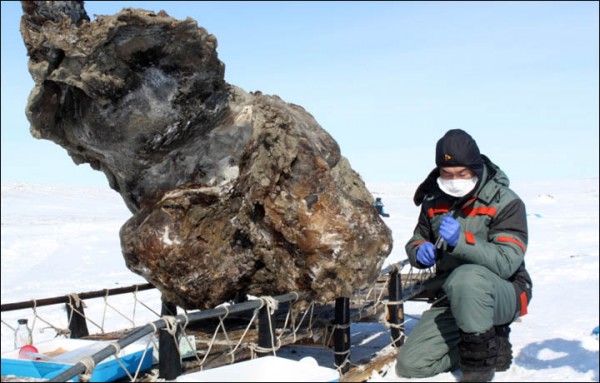Scientists Can Now De-Extinct Woolly Mammoths; Will They Walk the Earth Again?
| Ana Verayo | | Apr 25, 2015 09:45 AM EDT |
(Photo : Semyon Grigoriev) A portion of the female woolly mammoth found in Siberia with liquid blood is still present in the animal.
Scientists have finally completed the woolly mammoth genome, a feat that might bring these massive beasts that died out some 4,000 years ago back to life.
A team of U.S. scientists will use the mammoth genes and incorporate them with stem cells of modern elephants to gain a better understanding of the physical structure of the ancient creatures.
Like Us on Facebook
This new technique is called de-extinction. This breakthrough technology works by using DNA samples from already extinct creatures like the woolly mammoth and placing them into the cells of their modern counterparts.
Extinct animals such as dodo birds, passenger pigeons and others are being considered for de-extinction by scientists to recover animal losses caused by humans and to also promote biodiversity. Skeptics, however, deem this practice unethical.
Still, the mammoth genome analysis has revealed the ancient beast went through two major population losses. The third instance led to the final demise of the last population in an island located in the Arctic Ocean. The last of the mammoths found along the Russian coastline presented evidence of inbreeding.
Unlike dinosaurs, mammoths died only recently. Remains of the animals have been recovered under the Siberian ice in almost perfect condition with flowing blood.
Researchers thoroughly examined the genetic codes from a pair of mammoths, including a molar from a 4,000 year old specimen that used to live on Wrangel Island and a 45,000 year-old calf in Siberia. The more recent mammoth, which was a member of the last surviving mammoths, was found to possess less genetic variation due to inbreeding.
According to geneticist Love Dalén from the Swedish Museum of Natural History, this difference in the Wrangel specimen's genome contains a large number of tracts that has no variation at all, meaning it's typical in very small populations where matings occur between distant relatives.
This study was published in the journal, Current Biology.
TagsScientists Can Now De-Extinct Woolly Mammoths, Will They Walk the Earth Again?, woolly mammoths, de extinction woolly mammoths, genome woolly mammoths complete
©2015 Chinatopix All rights reserved. Do not reproduce without permission
EDITOR'S PICKS
-

Did the Trump administration just announce plans for a trade war with ‘hostile’ China and Russia?
-

US Senate passes Taiwan travel bill slammed by China
-

As Yan Sihong’s family grieves, here are other Chinese students who went missing abroad. Some have never been found
-

Beijing blasts Western critics who ‘smear China’ with the term sharp power
-

China Envoy Seeks to Defuse Tensions With U.S. as a Trade War Brews
-

Singapore's Deputy PM Provides Bitcoin Vote of Confidence Amid China's Blanket Bans
-

China warns investors over risks in overseas virtual currency trading
-

Chinese government most trustworthy: survey
-

Kashima Antlers On Course For Back-To-Back Titles
MOST POPULAR
LATEST NEWS
Zhou Yongkang: China's Former Security Chief Sentenced to Life in Prison

China's former Chief of the Ministry of Public Security, Zhou Yongkang, has been given a life sentence after he was found guilty of abusing his office, bribery and deliberately ... Full Article
TRENDING STORY

China Pork Prices Expected to Stabilize As The Supplies Recover

Elephone P9000 Smartphone is now on Sale on Amazon India

There's a Big Chance Cliffhangers Won't Still Be Resolved When Grey's Anatomy Season 13 Returns

Supreme Court Ruled on Samsung vs Apple Dispute for Patent Infringement

Microsoft Surface Pro 5 Rumors and Release Date: What is the Latest?










